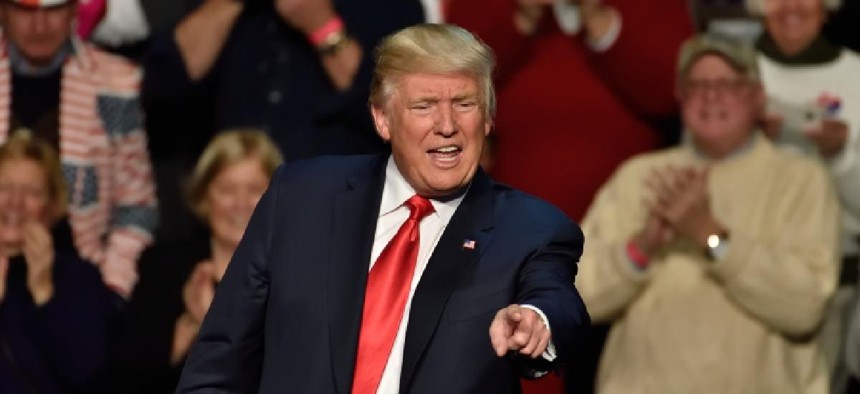Elections (Archived)
Unlocking the Keystone State's crimson tide in November

Then-president-elect Donald trump speaks at a rally in Hershey as part of his "Thank you" tour. Evan El-Amin/Shutterstock
As any candidate will tell you, losing an election by 10 percentage points is far preferable to losing by one point.
Lose by 10 points and you can go to bed knowing that there was nothing you could have done to change the outcome. The time and tides were against you and that’s that.
Losing by a single point, as one campaign manager once put it, is like dying from a thousand paper cuts. You enter your own private purgatory of “if”: If only I had raised a bit more money. If only I had run that last flight of negative ads. If only I had gone to that town one more time. If … if … if …
Hillary Clinton’s purgatory is located in Chappaqua, New York, where she can ponder in solitude – if not in peace – all the ”woulda coulda shouldas” of the 2016 presidential race, which she lost to Donald Trump, despite winning the popular vote by nearly 2.9 million votes.
In Pennsylvania, Clinton lost by three-quarters of one percent, receiving 44,292 fewer votes than her Republican rival, out of a record 6.1 million votes cast, according to certified returns from the Pennsylvania Department of State. So close, and yet so far.
There are plenty of analysts, looking in the rearview mirror, who will be happy to tell Clinton how she could have won the state. But let’s not diminish the tremendous feat Trump accomplished.
Not only was he the first Republican presidential candidate to win Pennsylvania in 28 years; he overcame the usually insurmountable barrier of losing southeast Pennsylvania. Clinton won in the eight-county Philadelphia media market by a margin of 660,000 votes – nearly the same margin that Barack Obama won in 2012.
Trump had to overcome that deficit in the rest of the state – a mathematical improbability, given that 42 percent of the state’s electorate lives in the southeast.
Yet, he did it by getting higher-than-normal turnout in his strongholds and by getting a greater share of the vote than recent Republican candidates.
One example: Mitt Romney won the 14-county Harrisburg media market by 163,000 votes in 2012. That was not a surprise. This area is the state’s Republican heartland. In November, Trump won the same area by 228,000 votes over Clinton.
In central Pennsylvania, Clinton received fewer votes than Obama did four years ago and Trump got more than Mitt Romney did in 2012. Outside the southeast, that pattern was repeated in every other area of the state: Obama voters defecting to Trump and Trump energizing additional conservative voters.
There were 214,000 more votes cast statewide in 2016 than four years before. Looking at the county-by-county turnout figures, most of those new voters cast their ballots for Trump.
What makes Trump’s feat all the more impressive is that he drew this support without any field operation and without airing many TV ads in Pennsylvania – certainly not in comparison to the Clinton campaign. In short, he won while breaking every rule in the modern campaign playbook.
And he did it while there was a strong third-party candidate on the ballot who surely drew away conservative votes: the Libertarian Party candidate Gary Johnson. Johnson was on the ballot in 2012 as well. He got 50,000 votes then. He got 147,000 votes in November.
Jill Stein, the Green Party candidate, was on the ballot as well in 2012. She received 21,300 votes then. In November, she got 49,900 votes. It’s another “if” to ponder over the next four years – as in, if Stein wasn’t on the ballot, could Clinton have won the state?
There are lots of ways to characterize the presidential vote: red vs. blue counties, conservatives vs. liberals, white vs. multi-racial cultures. In looking at the returns, though, what strikes me is how this election fell into another category: the big cities and their suburbs versus the small towns and rural areas of Pennsylvania. It harkens back to the earliest division in American politics: the rural Jeffersonians versus the urban Hamiltonian federalists. I won’t overdo the parallels other than to point it out.
I will add one final question to the pile to hopefully be answered over the next four years: Is this the beginning or the end? Are we at the dawn of a statewide conservative resurgence that will reverberate for years to come – for instance, when Gov. Wolf seeks re-election in 2018? Did Trump create the template on how to overcome the dominance of the southeast in the electoral equation?
Or, is this the crest of the Republican wave, a once-in-a-generation event made possible by a one-of-a-kind candidate? Trump, after all, is not a traditional mainstream Republican. He’s not a traditional mainstream anything. And he didn’t win his party’s nomination, so much as lead a hostile takeover.
The good thing about that question is that it will be answered eventually. Trump’s persona may have enthralled voters, but he also lured them in with a promise to restore their status in the world, no longer to be undermined by immigrants, nor ignored by the financial and political elites. Like all great salesmen, he sold them a dream. Now, all he has to do is deliver on it. ■
